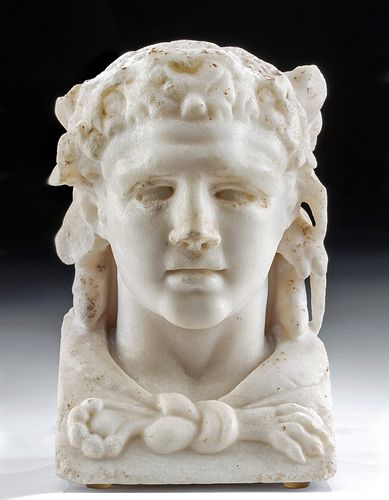Roman Marble Herm of Hercules - ex Royal Athena
Lot 49
About Seller
Artemis Fine Arts
686 S Taylor Ave, Ste 106
Louisville, CO 80027
United States
Selling antiquities, ancient and ethnographic art online since 1993, Artemis Gallery specializes in Classical Antiquities (Egyptian, Greek, Roman, Near Eastern), Asian, Pre-Columbian, African / Tribal / Oceanographic art. Our extensive inventory includes pottery, stone, metal, wood, glass and textil...Read more
Estimate:
$16,000 - $24,000
Absentee vs Live bid
Two ways to bid:
- Leave a max absentee bid and the platform will bid on your behalf up to your maximum bid during the live auction.
- Bid live during the auction and your bids will be submitted real-time to the auctioneer.
Bid Increments
| Price | Bid Increment |
|---|---|
| $0 | $25 |
| $300 | $50 |
| $1,000 | $100 |
| $2,000 | $250 |
| $5,000 | $500 |
| $10,000 | $1,000 |
| $20,000 | $2,500 |
| $50,000 | $5,000 |
| $100,000 | $10,000 |
| $200,000 | $20,000 |
About Auction
By Artemis Fine Arts
Feb 13, 2020
Set Reminder
2020-02-13 10:00:00
2020-02-13 10:00:00
America/New_York
Bidsquare
Bidsquare : Exceptional Antiquities, Asian, Ethnographic
https://www.bidsquare.com/auctions/artemis-gallery/exceptional-antiquities-asian-ethnographic-4848
An important one-day auction featuring museum-worthy examples of Egyptian, Greek, Roman, Etruscan, Near Eastern, Far East / Asian, Pre-Columbian, African / Tribal, Oceanic, Native American, Spanish Colonial, Russian, Fossils, Ancient Jewelry, Fine Art, so much more! Artemis Fine Arts info@artemisfinearts.com
An important one-day auction featuring museum-worthy examples of Egyptian, Greek, Roman, Etruscan, Near Eastern, Far East / Asian, Pre-Columbian, African / Tribal, Oceanic, Native American, Spanish Colonial, Russian, Fossils, Ancient Jewelry, Fine Art, so much more! Artemis Fine Arts info@artemisfinearts.com
- Lot Description
Roman, Imperial Period, ca. 1st century CE. An incredibly preserved marble herm of Hercules (Heracles), here depicted as very youthful, with an almost childlike face, deepset eyes under a heavy brow, a broad nose, and a full mouth. His hair features tight curls, visible underneath a cloak decorated with leaf-like motifs. Below his athletic neck, resting on his collarbone and carved in relief, are the paws of a lion, tied tightly to form a cloak - one of Hercules' most famous attributes. The marble the herm is carved from is of very high quality, with an almost pure white surface - though when originally carved, it would have been brightly painted and there are some remains of original pigment visible, especially on the head. Size: 6.9" H (17.5 cm)
Hercules was a massively popular hero in ancient Rome (with much of it derived, as so many elements of Roman culture were, from Greece - entering Roman culture by way of Etruria). Both Mark Antony and the Emperor Commodus considered him to be a personal patron god. The story of Hercules and the Nemean Lion was retold over and over again, in plays, painting on vases, and sculptures. As part of his labors, Hercules was sent by King Eurystheus to bring him the skin of a lion that was terrorizing the town of Nemea. Upon discovering that weapons would not work on the beast, he tracked it to its lair and strangled it.
Herm or herma are sculptures with a head and sometimes a torso and male genitals carved on a square base. They are thought to derive from the ancient Greek practice of worshipping divinities that were in the form of cairns or columns of stone or wood. These later evolved into adding a head and phallus to the column. Many herma are of Hermes himself, but others - both gods like Hercules and real figures like Socrates and Plato - are known. Sculptures like this one were apotropaic and kept in many places - at crossroads, in temples, in public places, and in homes. This figure would have been protective for its owner and, given its remarkable artistry and beautiful material, would have been a highly prized item kept in an elite Roman home.
Published: Royal-Athena Galleries, Art of the Ancient World, New York, 1995, p. 71, no 226
Provenance: private New York, USA collection; ex-Royal-Athena Gallery, New York, New York, USA, acquired in 1985; ex-Joseph S. Melchione collection
All items legal to buy/sell under U.S. Statute covering cultural patrimony Code 2600, CHAPTER 14, and are guaranteed to be as described or your money back.
A Certificate of Authenticity will accompany all winning bids.
We ship worldwide and handle all shipping in-house for your convenience.
#152811Great preservation of detail. Light wear commensurate with age including some small pits and deposits on the surface.Condition
- Shipping Info
-
All shipping is handled in-house for your convenience. Your invoice from Artemis Gallery will include shipping calculation instructions. If in doubt, please inquire BEFORE bidding for estimated shipping costs for individual items.
-
- Buyer's Premium



 EUR
EUR CAD
CAD AUD
AUD GBP
GBP MXN
MXN HKD
HKD CNY
CNY MYR
MYR SEK
SEK SGD
SGD CHF
CHF THB
THB















